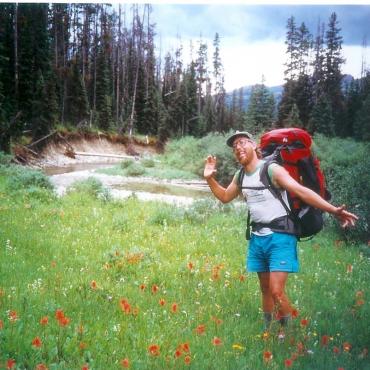Survival with Style
Owing to the fact that humans have two legs and two arms, many items come in pairs: gloves, socks, shoes, boots, crampons, poles, skis. Most of these items are nearly useless without their mate—just like your humble author.
Lost socks usually turn up under the bed or in a packrat nest. If not, you have a sock puppet. Skis, however... if you’ve put in your time on the slopes, you know that it's all too easy to lose one or both of your skis in deep powder. Many kinds of ski bindings are designed to release during a fall to lessen the chance of injury. If your ski isn’t clipped to you with a leash, you may lose it. Ski brakes help—to a point. I recall watching a ski with brakes projectiling down the South Bowl, threatening to skewer the nearest North Dakotan. Leashes can be deadly too, since a windmilling ski attached to you by a rope can beat you senseless. And leashes can turn a ski into an anchor during an avalanche, dragging you to your doom.
Not only is it a bummer to have only one ski, it can be life-threatening. Try hoofing it out through five miles of deep powder, post-holing up to your hips while your ski boots fill with snow. Or try skiing across the flats, or up hill, on one ski. Impossible. You may be truly stranded, especially if you were dumb enough to go alone.
If your skis come off in a fall: good. They’re supposed to—assuming you have releasable bindings, and it makes for better entertainment for the gawkers on the lift.
Size up the Situation. Take stock, stand up, make sure you are okay first. Then do a visual scan of the area and collect gear from your yard sale.
Get Assistance. Ask your friends to help, or ask other nearby skiers for assistance. Don’t be shy—they’ve all been there and most will be happy to assist.
Be Systematic. If something is missing, look back along your fall line. Mostly likely the ski or pole is uphill from you, buried. Mark where you landed, and start digging in the snow or systematically probing with your pole. If you don’t find your lost item uphill, start searching downhill, along the fall line. Even with brakes, a ski can travel under the snow.
Know When to Quit. Skis and poles can be replaced. Your toes cannot. If you can’t get out from where you are without skis, send someone or call for help. Things can get cold fast when the sun goes down, so factor in exactly how much time you have you need to pull out your headlamp.
Don’t Get Tunnel Vision. It's easy to lose other essential items in the snow. If you stop on a steep slope and put down your pack, watch where the hell you put it. I had to chase my overnight pack a hundreds yards downhill in the Lee Metcalf Wilderness after some trees arrested its headlong plunging roll into oblivion. One friend of mine died when he lunged for his pack and followed it over the cliff. If it comes to that, let it go!
To prevent lost skis altogether, consider powder cords that pull out from a pouch on your ski pants and float behind the ski when it takes off. You can also set up something called a “thong leash” (no, it's not an S&M toy) that will attach your ski to you but break if put under enough stress—that is, if the ski is dragged under in an avalanche or caught on a tree as you plunge downhill.
Brakes or leashes are required at ski areas. In the backcountry, it’s a matter of preference, ski ability, and terrain. Either way, if you lose a ski and survive, you can always add the other one to your hippie ski fence.













